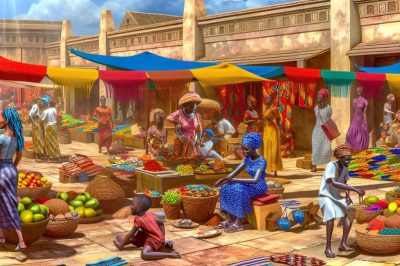Overview of Trading in Africa
Africa’s trading landscape is as diverse as its numerous economies. With a rapidly growing population, abundant natural resources, and increasing connectivity, the continent presents unique opportunities and challenges for both local and international traders. This comprehensive exploration delves deeper into the intricacies of Africa’s trading environment, capturing the essence of its economic growth, major trade commodities, pressing challenges, and the promising role of technological advancements.
Economic Growth and Regional Integration
Africa’s economic narrative in recent years has been one of resilience and potential. Several African nations have experienced robust economic growth over the past decade. This growth is largely attributed to improved governance frameworks that have encouraged investments and infrastructural expansion. Improved governance has also played a part in the political stability that sets a foundation for economic activities.
Investments in infrastructure, such as roads, ports, and electricity grids, have furthered economic activities by reducing production costs and enhancing trade efficiency. The youth demographic, forming a significant portion of the population, is both a labor force and a consumer base fueling demand across various sectors. Regional economic communities such as the African Union (AU) and the African Continental Free Trade Area (AfCFTA) are playing a significant role in promoting economic integration. The AfCFTA, launched in 2019, aims to create a single continental market for goods and services, facilitating trade across borders and reducing tariffs. It promises to increase intra-African trade by up to 52% by 2022, which exemplifies the commitment to unifying over 50 countries under a single trade framework.
Key Commodities and Trade Partners
Africa’s wealth in natural resources positions it strategically in the global commodities market. The continent is a significant exporter of minerals such as gold, diamonds, and platinum. These minerals are integral to both local economies and international industries, from jewelry to electronics and automotive manufacturing. Furthermore, Africa dominates the agricultural export sector with products like cocoa, coffee, and cotton.
The continent’s main trading partners include the European Union (EU), China, and the United States. These partnerships are not only about resource extraction but also investment and development collaborations. The EU, for instance, is actively involved in trade agreements and development aid. China has marked its presence significantly with its investments in infrastructure and manufacturing, while the United States maintains a balanced trade agreement focus.
Challenges Facing Trade in Africa
Despite positive strides, several challenges hinder trade in Africa. The infrastructural deficits remain a bottleneck for efficient trade. Inadequate transportation networks, such as underdeveloped roads and limited rail connectivity, result in higher logistical costs. These challenges are compounded by unreliable power supply which affects manufacturing and other trade-related activities.
Bureaucratic hurdles and regulatory inconsistencies across countries can complicate cross-border trade. The varying customs procedures and trade regulations require clear understanding and compliance, often necessitating strategic partnerships with local entities. Political instability and security concerns in some regions further exacerbate these challenges. Countries experiencing turmoil face disruption in trade routes and renegotiation of trade deals.
Furthermore, there is a need for enhanced financial collaboration and currency stability to support trade operations. Currency fluctuations affect export competitiveness and pricing structures, indicating a critical area for policy development.
Technological Advancements and Opportunities
Amidst the challenges, Africa’s digital revolution is opening new avenues for trade. Mobile technology and internet access have surged, particularly in urban areas, facilitating e-commerce and digital payments. The adoption of mobile technology is at the forefront, with exciting innovations in mobile payments systems allowing easier financial exchanges and reduced transaction times.
Fintech innovations are transforming the financial landscape, making it easier for businesses and consumers alike to engage in trade. Mobile banking has significantly reduced the unbanked population, providing financial inclusion and stability. Platforms offering micro-loans and mobile credit systems are becoming prevalent, providing economic empowerment to small and medium-sized enterprises (SMEs).
Connectivity improvements also support digital infrastructure development, which continues to promise substantial growth in the online trading sectors. E-commerce platforms are finding a foothold, leveraging social media and mobile apps to reach consumers beyond traditional market spaces. Governments are also investing in tech start-ups and digital skills training, fostering a vibrant entrepreneurial ecosystem.
For those interested in exploring trade opportunities in Africa, understanding the unique economic, geographical, and social dynamics is crucial. Engaging with local partners and staying informed on regional policies will be vital for success in this diverse and rapidly evolving market. Businesses should seek resources and platforms that offer insights into market trends and trade regulations. One such platform to consider is the West Africa Trade & Investment Hub, which provides valuable information and opportunities for trade engagement in Africa.
In conclusion, Africa’s trading landscape is a tapestry woven with opportunities represented by its rich natural resources, challenges seen in its infrastructural and regulatory hurdles, and the promising horizon of a technology-driven future. The continent stands at a significant point of transformation, poised to partake more actively in global trade, while offering a diverse market waiting to be tapped. With strategic collaborations and a focus on sustainable growth, the potential of Africa’s trade ecosystem remains boundless.





